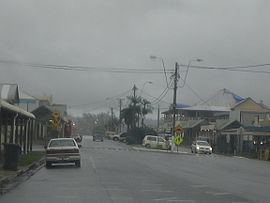Population 1,068 (2011 census) State electorate(s) Mulgrave Mean min temp Annual rainfall Local time Tuesday 1:09 AM | Postcode(s) 4861 Mean max temp Mean min temp Postal code 4861 | |
 | ||
Weather 24°C, Wind S at 8 km/h, 89% Humidity | ||
Babinda is a small town and suburb in the Cairns Region, Queensland, Australia. It is located 60 kilometres (37 mi) south of Cairns. At the 2011 census the town recorded a population of 1,068.
Contents
- Map of Babinda QLD 4861 Australia
- History
- Heritage listings
- Demographics
- Community
- Schools
- Attractions
- Transportation
- Climate
- References
Map of Babinda QLD 4861, Australia
The town is noted for its proximity to two of Queensland's highest mountains Mount Bartle Frere and Mount Bellenden Ker.
Babinda and Tully annually compete for the Golden Gumboot, an award for Australia's wettest town. Babinda is usually the winner, recording an annual rainfall of over 4,200 millimetres each year.
History
Babinda takes its name from the local Indigenous Australian language for mountain. Other sources, however, claim it is a Yidinji word for water, possibly referring to the high rainfall of the area.
Babinda State School opened on 4 November 1914.
Babinda Post Office opened by 1915 (a Babinda Creek receiving office had been open since 1891).
The Babinda War Memorial was unveiled by the chairman of the Cairns Shire Council Seymour Warner on 25 April 1927.
In March 2006, Babinda was struck by Cyclone Larry, damaging up to 80% of buildings.
Heritage listings
Babinda has a number of heritage-listed sites, including:
Demographics
The 2006 Census by the Australian Bureau of Statistics counted 1,167 persons in Babinda on census night. Of these, 49.7% were male and 50.3% were female.
The majority of residents (79.7%) are of Australian birth, with other common census responses being Italy (2.7%) and New Zealand (2.0%).
The age distribution of Babinda residents is skewed slightly higher than the greater Australian population. 70.1% of residents were over 25 years in 2006, compared to the Australian average of 66.5%; and 29.9% were younger than 25 years, compared to the Australian average of 33.5%.
Community
The local newspaper is the Innisfail Advocate. There are many different community events in Babinda. The annual Harvest Festival is celebrated in June and features some unusual events including the Sugar Bowl competition, the Gumboot Toss and the Umbrella Toss (reflecting Babinda's connection to the sugar industry and its wet weather). The festival has been running since the 1960s but did not occur in 2006 due to Cyclone Larry.
Schools
Babinda is served by Babinda P-12 State School, on Boulders Road, and St Rita's School, on Church Street.
Attractions
The Boulders and Devil's Pool are popular tourist attractions. A picnic area is located nearby, beside Babinda Creek.
Transportation
Babinda is situated on the Bruce Highway. The town has a railway station for access to long-distance train services, namely The Sunlander and the Tilt Train.
Climate
Babinda is well known and recognised as the wettest town in Australia, with an annual average rainfall of 4279.4 mm. Monthly totals over 1000 mm are not uncommon, and sometimes, usually between January and April, whole months will go by without a single sunny day. The wet season lasts from December to May, while the 'dry season' occurs from June to November. During the wet season, heavy monsoonal downpours occur almost daily and occasionally even heavier rain from tropical lows or cyclones occurs. Rainfall still totals well over 100mm a month during the dry season; however, is usually in the form of coastal showers, which can range from 1 or 2 millimeters, to brief 100mm+ downpours. Thunderstorms with dangerous lightning and damaging winds can be a threat from October to December; however, this threat decreases when the monsoon begins to take over in January.
